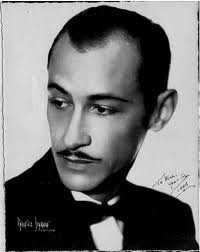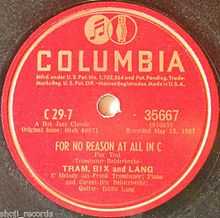Frankie Trumbauer
| Frankie Trumbauer | |
|---|---|
 | |
| Background information | |
| Birth name | Orie Frank Trumbauer |
| Also known as | Tram, Frankie |
| Born | 30 May 1901 |
| Origin | Carbondale, Illinois, U.S. |
| Died | 11 June 1956 |
| Genres | Jazz, dixieland |
| Occupations | Saxophonist, Bandleader, Composer |
| Instruments | saxophone |
Orie Frank ("Frankie" or "Tram") Trumbauer (May 30, 1901 – June 11, 1956) was one of the leading jazz saxophonists of the 1920s and 1930s. He played the C-melody saxophone which, in size, is between an alto and tenor saxophone. He also played alto saxophone, bassoon, clarinet and several other instruments.
He was a composer, notably of technically sophisticated sax melodies, and was one of the major jazz bandleaders of the 1920s and 1930s. His landmark recording of "Singin' the Blues" with Bix Beiderbecke and Eddie Lang in 1927, was inducted into the Grammy Hall of Fame in 1977. His major recordings included "Krazy Kat", "Red Hot", "Plantation Moods", "Trumbology", "Tailspin", "Singin' the Blues", "Wringin' an' Twistin'", and "For No Reason at All in C" with Bix Beiderbecke and Eddie Lang, and the first hit recording of "Georgia On My Mind" in 1931.
Career
Born of part Cherokee ancestry in Carbondale, Illinois, Frank Trumbauer grew up in St Louis, Missouri, the son of a musical mother who directed saxophone and theater orchestras. His first important professional engagements were with the Edgar Benson and Ray Miller bands, shortly followed by the Mound City Blue Blowers, a local group that became nationally famous through their recordings on Brunswick.
"Tram" was one of the most influential and important jazz saxophonists of the 1920s and 1930s. He is also remembered for his musical collaborations with Bix Beiderbecke, a relationship that produced some of the finest and most innovative jazz records of the late 1920s. Trumbauer and Beiderbecke also collaborated with jazz guitarist Eddie Lang.
Frankie Trumbauer recruited Bix Beiderbecke for Jean Goldkette's Victor Recording Orchestra, of which he became musical director. After leaving Goldkette, he and Beiderbecke worked briefly in Adrian Rollini's short lived "New Yorkers" band, then joined Paul Whiteman in 1927. In 1927, Trumbauer signed a contract with OKeh and released a 78 recording of "Singin' the Blues", featuring Beiderbecke on cornet and Lang on guitar. "Singin' the Blues" was a jazz classic originally recorded and released by the Original Dixieland Jazz Band in 1920. The Okeh recording became a smash hit. Fletcher Henderson and His Orchestra covered the song in 1931 in the Trumbauer-Beiderbecke version.
Trumbauer played with Whiteman for eight of the following nine years. He had a separate contract with OKeh Records from 1927 through 1930, he recorded some of the most legendary small group Jazz recordings of the era, usually including Beiderbecke until the April 30, 1929, session. He recorded a handful of sides in 1931 for Brunswick. In 1932 he organized a band in Chicago and recorded for Columbia, but gave up the orchestra and returned to New York late in 1933. During 1934–1936, while again a member of Paul Whiteman's Orchestra, he also made a series of recordings for Brunswick and Victor, often including Jack Teagarden.
In 1936 he led The Three T's, featuring the Teagarden brothers; in 1938, he and Manny Klein started a band which they co-led. In 1940, Trumbauer, a skilled pilot, left music (after recording a series of records for Varsity) to join the Civil Aeronautics Authority. During World War II he was a test pilot with North American Aviation, and trained military crews in the operation of the B-25 Mitchell bomber. He continued to work for the CAA after the war, and also played in the NBC Orchestra. After 1947, although he continued to play and record, he earned most of his income in aviation.
Trumbauer died of a sudden heart attack in Kansas City, Missouri, where he had made his home for some years. He was 55 years old.
Frankie Trumbauer suggested to Hoagy Carmichael that he compose the jazz and pop standard "Georgia on My Mind". In 1931, Trumbauer had the first hit recording of "Georgia on My Mind", which reached the top ten on the charts.
Trumbauer's cool, delicate style and slow vibrato influenced many important saxophonists, including Benny Carter, Lester Young and Art Pepper. According to the Red Hot Jazz website, "Trumbauer's solo on Trumbology is one of the most influential saxophone parts in the history of Jazz."
Lester Young acknowledged and cited Frankie Trumbauer as his main influence as a saxophonist. When an interviewer asked Young about his influences, he stated that Frankie Trumbauer was his major influence: "So, it's Trumbauer?" Young replied: "That was my man."
His life and career were documented in the biography Tram: The Frank Trumbauer Story by Philip R. Evans and Larry F. Kiner with William Trumbauer (Institute of Jazz Studies, Rutgers and Scarecrow Press Inc., 1994).
Compositions by Frankie Trumbauer
His compositions include "Trumbology" (1927), "Plantation Moods" with David Rose, "Red Hot", "Wringin' an' Twistin'" with Fats Waller, "Barbed Wire Blues", "Troubled", "I Like That", "Bass Drum Dan", "Break it Down", "I'm Glad", "Choo Choo", "Sun Spots", "Eclipse", "Meteor", "Krazy Kat", "G Blues", "Tailspin" with Jimmy Dorsey, "Crying All Day", "Loved One", "Apple Blossoms" with Joe Venuti, Lennie Hayton, and Eddie Lang, "Three Blind Mice" with Chauncey Morehouse, "The Mayor of Alabam'", "Flight of a Haybag", "Cinderella's Wedding Day", "Runnin' Ragged", and "For No Reason at All in C" with Bix Beiderbecke in 1927, which was released as a single on Okeh, Columbia, and Parlophone.
Major Recordings


- "I'm Glad"/"Flock O' Blues," Sioux City Six featuring Bix Beiderbecke and Miff Mole, recorded October 11, 1924, New York, released as Gennett 5569
- "Clarinet Marmalade"/"Singin' the Blues," recorded on February 4, 1927, in New York and released as Okeh 40772
- "Riverboat Shuffle"/"Ostrich Walk," recorded May 9, 1927, New York, Okeh 40822
- "I'm Coming, Virginia"/"Way Down Yonder in New Orleans," recorded on May 13, 1927, in New York and released as Okeh 40843
- "For No Reason at All in C"/"Trumbology," recorded on May 13, 1927, in New York and released as Okeh 40871, Columbia 35667, and Parlophone R 3419
- "Wringin' an' Twistin'," recorded on September 9, 1927, in New York and released as Okeh 40916 and Vocalion 3150
- "Krazy Kat (Tone Poem In Slow Rhythm)," recorded September 28, 1927, New York Okeh 40903
- "Baltimore" b/w "Humpty Dumpty," recorded September 28, 1927, New York, Okeh 40926
- "Mississippi Mud" (vocal by Bing Crosby)/"There'll Come a Time (Wait and See)," January 9, 1928, New York, Okeh 40979
- "Ol' Man River" (From "Show Boat") recorded with Paul Whiteman and His Orchestra on January 11, 1928 in New York and released as Victor 21218-A and Victor 25249 with Bing Crosby on vocals and Bix Beiderbecke on cornet. No. 1 for 1 week
- "Borneo"/"My Pet," recorded on April 10, 1928, in New York and released as Okeh 41039
- "Georgia On My Mind," recorded September 24, 1931, Chicago, Illinois, Brunswick 6159
- "Troubled"/"Plantation Moods," recorded November 20, 1934, New York, Victor 24834, HMV B.D. 158 in the UK
Honors
"Singin' the Blues", released by Frankie Trumbauer and His Orchestra featuring Bix Beiderbecke on cornet and Eddie Lang on guitar in 1927 as Okeh 40772-B, was inducted into the Grammy Hall of Fame in 1977. Frankie Trumbauer played the C-melody saxophone solos on the landmark jazz recording.
In 2006, his 1927 recording of "Singin' the Blues" with Bix Beiderbecke and Eddie Lang was placed on the U.S. Library of Congress National Recording Registry.
In 2008, his recordings of "Ostrich Walk" and "There'll Come a Time" with Bix Beiderbecke were included on the soundtrack to the Brad Pitt movie The Curious Case of Benjamin Button, which was nominated for 13 Academy Awards, based on the F. Scott Fitzgerald short story from Tales of the Jazz Age.
External links
- "A Toast for Tram" by Ted Gioia at Jazz.com
- photograph of Frankie Trumbauer playing the saxophone
- Frankie Trumbauer and His Orchestra featuring Bix Beiderbecke and Pee Wee Russell: http://www.redhotjazz.com/ftoinfo.html
|